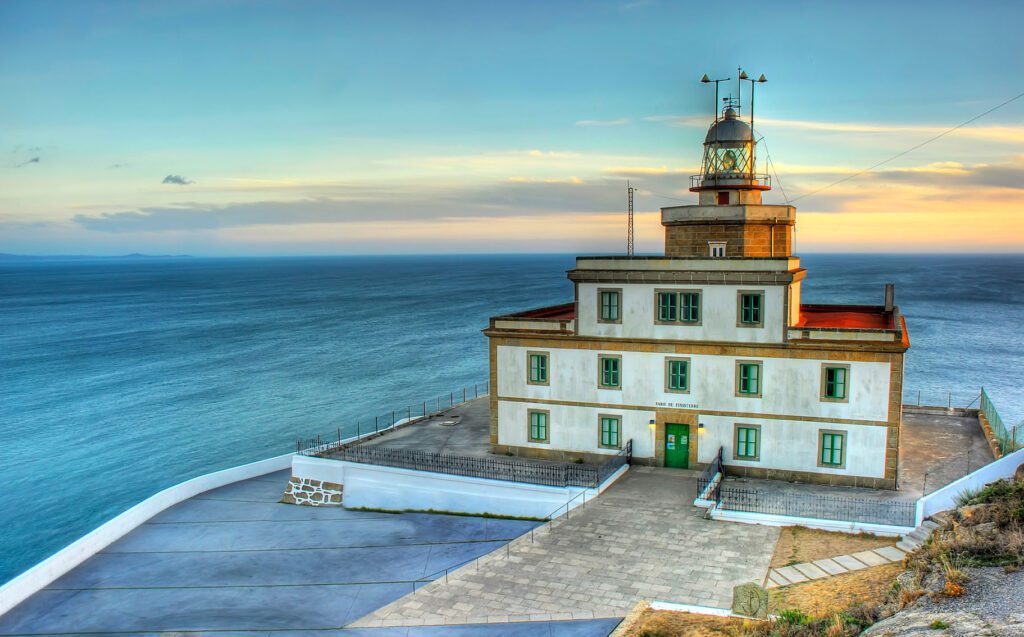BEST LIGHTHOUSES IN GALICIA

BEST LIGHTHOUSES IN GALICIA Galicia is a land of the sea and that is why it has multiple lighthouses, today we show you the best. Each one has its history and its beauty, which is why many travelers decide to take a route to get to know them. In this case, you will be able to see 6 of them that, in addition to their normal use, now some have become rural accommodation or are points of tourist interest. The best thing is that you can do the lighthouse routesin a motorhome, on a bicycle, or on foot. Fisterra Lighthouse (A Coruña) This lighthouse gets its name from the cape where it is located. In fact, this cape is one of the most visited capes in Europe and the closest to America. Cape Fisterra arose in Roman times when it was thought that this was the westernmost point of the peninsula and where the world ended, which is why it was called “finis terrae”. Be that as it may, this place is one of the best known by sailors for its danger, since several ships have been shipwrecked here throughout its history. From the lighthouse you can contemplate the fantastic views of the seaand the wild landscape that surrounds it. As for the lighthouse, it is a construction from 1853 that has an octagonal tower and the lighthouse keeper’s house. The lighthouse was built at 138 meters above sea level and its light reaches 65 kilometers in length. The best? Enjoy the sunset to see the sun as it disappears into the immensity of the ocean. Cabo Home Lighthouse (Pontevedra) This lighthouse is located at the end of Cape Home. It stands out for being one of the tallest towers in Galicia and for its white and blue color that stands out among the landscape. Like the Fisterra Lighthouse, this one was also built in 1853. It is 18 meters high and its span reaches 12 kilometers. Its main function is to mark the entrance of the Vigo estuary between the Cíes Islands and the Costa da Vela. As a curiosity, we should say that due to the dense fog that often appears in this place, it was decided to install a siren in 1888 called “Vaca de Fisterra” to warn sailors of the danger. In addition, this lighthouse is located in one of the most beautiful coastal areas of the Rías Baixas where there is an 8-kilometer circular route Perfect to go with children. During the tour you will also be able to see the Punta Robaleira Lighthouse, smaller and red in color. Roncudo Lighthouse (A Coruña) Its name comes from the loud hoarse sound that waves make when they hit the rocks of the cliffs. It is a simple lighthouse built in 1920 that has a height of 11 meters. The surrounding landscape stands out for its granite stones, which make it wild and mysterious. In addition, this place is well known for the famous Roncudo barnacle, considered the most delicious in Galicia. Here the barnacles work in extreme conditions to obtain this precious delicacy, some of them have even lost their lives, which is why two crosses were placed in honor of them. On the other hand, this place is also very dangerous for boats, some of which have also shipwrecked in the waters of the dreaded A Costa da Morte. Even so, it is still a special place where you can contemplate the immense blue sea of the Galician landscape. Cape Vilán Lighthouse (A Coruña) Also called Cabo Vilano, this lighthouse is one of the classics of Galicia. Being on the Costa da Morte it is normal for there to be winds of up to 200 km/h and waves several meters high, making it an inhospitable and dangerous place. On the contrary, it is located in an enclave declared a Natural Site of National Interest. It is the oldest electric lighthouse in Spain, built in 1896. Currently, the lighthouse keeper’s house houses an Interpretation Center where the history of the lighthouse, the shipwrecks and which houses some of the maritime pieces of the Costa da Morte are told. Precisely, one of the best-known stories of this place is the shipwreck of the English ship HMS Serpent in 1890. Tower of Hercules (A Coruña) It is a mix between a tower and a lighthouse located on a hill and with a height of 55 meters. It was built in the 1st century and is the only and oldest Roman lighthouse in operation. In addition, it is the third highest lighthouse in Spain, behind the Chipiona Lighthouse, the highest at 62 meters, and the Maspalomas Lighthouse, at 60 meters and was declared a World Heritage Site by UNESCO in 2009. As a curiosity, it should be mentioned that this lighthouse was known as Brigantia Lighthouse. Currently this lighthouse can be visited and climbed the 234 stepsto the top of its tower where they will explain the history and importance of this building. Of course the name is very mythological, which is why the lighthouse hides several legends related to Greek mythology. Pancha Island Lighthouse (Lugo) The Pancha Island Lighthouse is an example of a lighthouse hostel, so you can sleep in an authentic lighthouse. It was built in 1857 and is still active today, lighting the way for ships. The curious thing about this lighthouse is that it is located on a small island connected to the peninsula by a road over the sea. On the island there are two buildings, on the one hand, the old original lighthouse building painted blue and white, and on the other, a small cylindrical black and white lighthouse. The best thing about this place is that in the month of April the cat’s claw plant colors the surroundings of the island pink. Finally, you can find out about all our excursions in this link.
